Fox Mating Season: When Do They Breed?
@media (min-width: 481px) {
.mobile-top-content {
display: none;
}
}
#mobileTopContentCTACarouselControls { overflow: hidden; text-overflow: ellipsis; white-space: nowrap; }
.mobile-top-content .more { color: #fff; }
.mobile-top-content a { color: #fff; text-decoration: underline; }
.mobile-top-content a:hover { color: #fff; text-decoration: underline; }
@media (max-width: 480px) {
.mobile-top-content {
background-color: #06a10b;
color: #fff;
text-align: center;
/*height: 60px;
padding-top:5px;*/
font-size:80%;
/* display: block; */
margin: 0px -30px;
}
}
As widespread members of the Caninae subfamily, foxes live on every continent aside from Antarctica. They live in forests, grasslands, deserts, mountains, and the arctic. As part of the genus Vulpes, they’re set apart from other canines like dogs, wolves, jackals, and coyotes. Foxes are smaller in size and length and have a bushier tail and flatter skull. There are twelve species of true foxes. Many species are monogamous, choosing one partner and mating for life. Let’s take a look at the fox mating season and find out when they breed.
When Is Fox Mating Season?
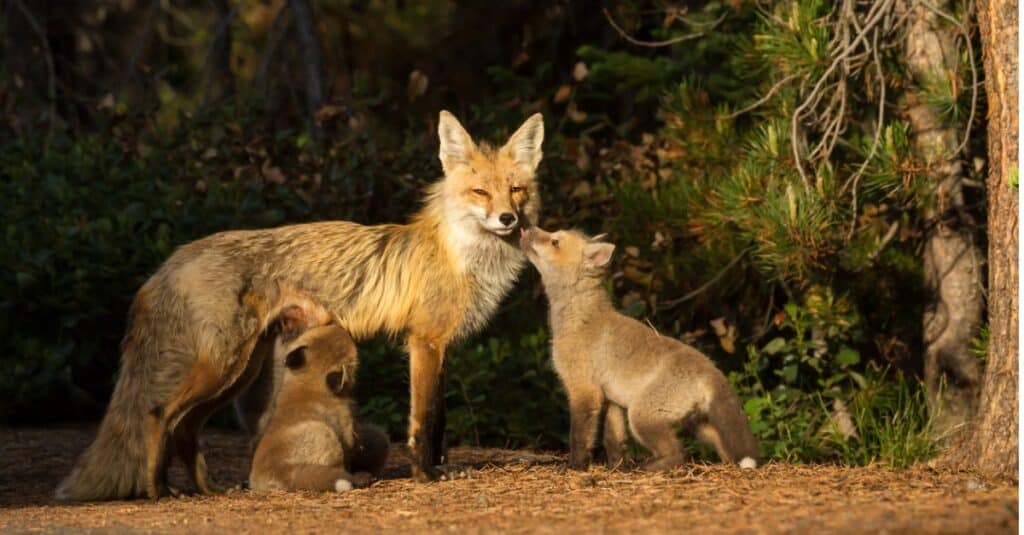
iStock.com/Wendy/Jeff Sparks/Torquemada
Fox mating season for most species occurs during the winter months of December through February. These mammals have a gestation period that averages 52 days. The young are then born in dens during the Spring.
Mating season varies by species, as foxes are widespread globally, and breeding may be influenced by the local climate and other factors. Below, we’ll take a look at the 12 true fox species and discover the variations in mating season timing.
Signs of Mating Season
Loud screeching noises that sound like crying are the mating calls of foxes, which may be heard out in the wild during the winter months. The screams and barks of urban foxes may wake the neighborhood during fox mating season. As males roam neighboring territories searching for receptive females, road deaths can be more common during this time.
Vixens, Tods, and Pups
A female fox is called a vixen, while a male is referred to as a tod or dog fox. Baby foxes are called kits, pups, or cubs. Many species tend to mate for life, but these pairs may or may not remain monogamous throughout that time. The practice of monogamy or promiscuity within foxes is based primarily on resource availability and population density. The vixens come estrous for 1 to 6 days during fox mating season, during which time they are receptive to being mated. The dog fox will ‘mate guard’ during this period, usually trailing the vixen as they sleep, hunt and travel together. He will fight with competing males if need be. Once mating has taken place, there is a gestation period of around 52 days before the young are born.
The vixens give birth in underground dens to a litter of 1 to 6 pups. Their eyes and ears remain closed for 10 to 15 days, so they are totally dependent on their parents for care and protection. Both parents usually care for the young, and the male fox will procure food for the female for weeks after she’s given birth. The babies are usually weaned at about 6 to 7 weeks old. They remain in the den for about a month and will remain with their parents until the fall.
Mating Season By Species
Red Fox
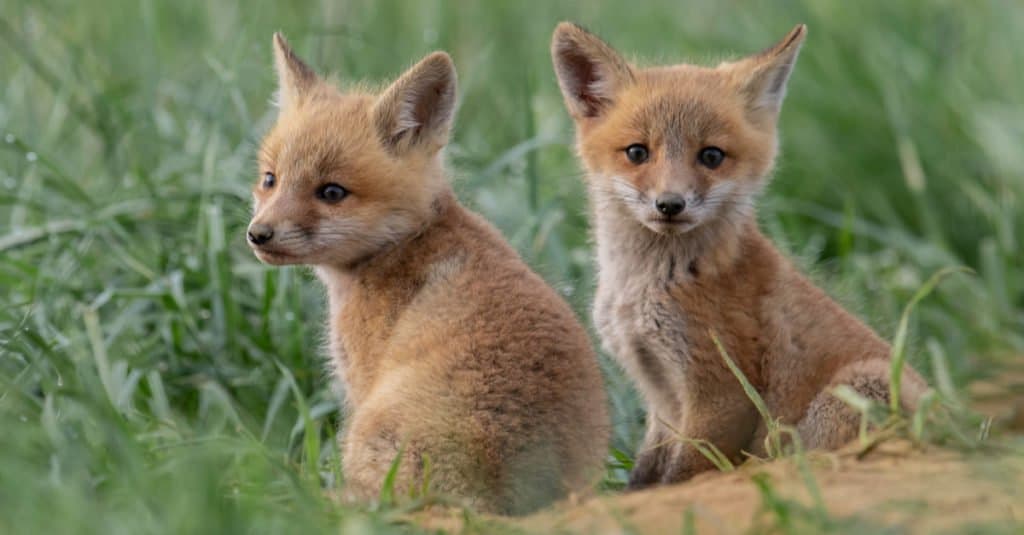
The largest species of fox is the red fox. They live in various regions in the Northern Hemisphere, from the Arctic Circle well into South America. They mate from late December through March, with most matings taking place in January and February. The vixens give birth to 4 to 5 pups in the spring. They tend to be solitary animals, aside from breeding season. Red Foxes appear to be a monogamous species.
Arctic Fox
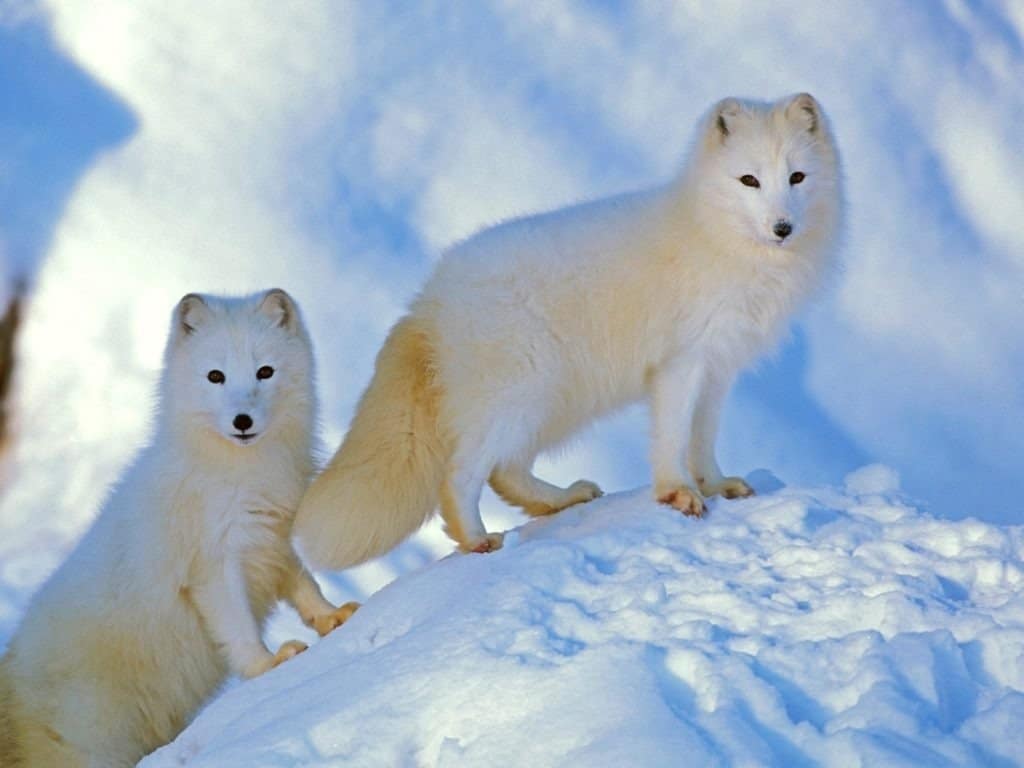
rokopix/Shutterstock.com
Also called the polar fox, snow fox, or white fox, the arctic fox is well adapted to the cold climate of the Arctic tundra of the Northern Hemisphere. Mating season takes place in early March through early April. After gestation, the mother fox gives birth to a litter that averages 7 pups but may be as large as 15. These pups are born in dens 6 to 12 feet underground, carved out in sandy, well-drained soils of low mounds and river banks. The breeding range of the Arctic fox is primarily in the coastal regions of Canada and the High Arctic islands. As a monogamous species, both parents participate in rearing the pups. The family units that are formed during the breeding season tend to break up during September and October, and they lead a solitary life during the winter months.
Fennec Fox
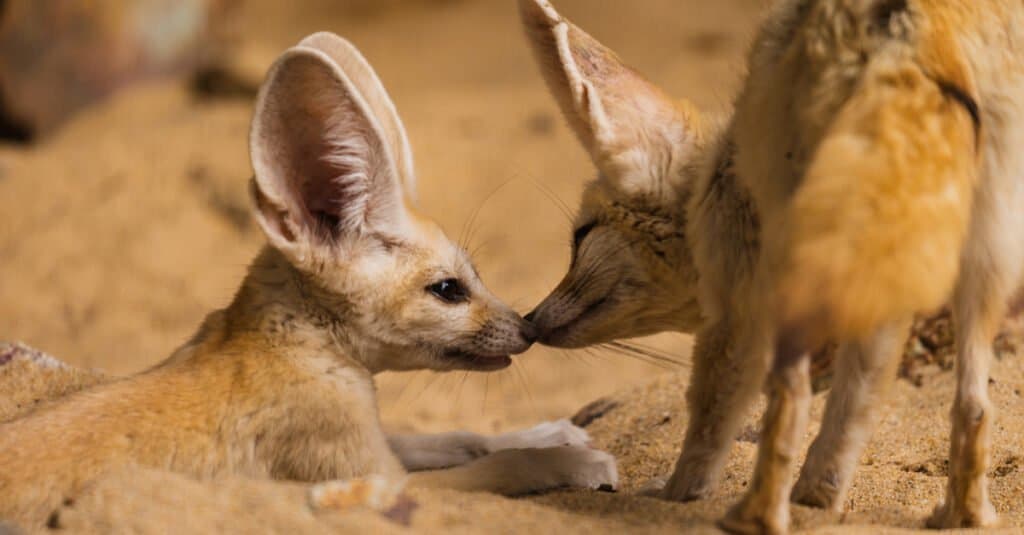
pianoman555/Shutterstock.com
The smallest of all fox species, fennec foxes are native to the Sahara Desert, Sinai Peninsula, and the Arabian Desert. They have large ears, which help dissipate heat from their bodies. These animals are social creatures that dig burrows in the sand for habitation and protection and live in groups of up to ten individuals. They are nocturnal creatures who burrow underground to escape the desert heat. They’re also a monogamous species. Although their breeding season in the wild is not well documented, it’s believed to take place from January to February, with females giving birth to kits in March or April in their underground burrows.
Pale Fox
Pale foxes have sandy-colored coats that blend into the desert habitat of the Sahel region of Africa, where they live. Due to their remote habitat and exceptional camouflage, pale foxes are one of the least studied of all canids. They’re known to live in small family groups within underground burrows. Three adults usually form a pack in this species, with one female and two males. Their mating season is unknown, but mothers typically give birth to 3 to 6 pups.
Blanford’s Fox
Also known as the Afghan fox, royal fox, and dog fox, the Blandford’s fox lives in parts of Central Asia and the Middle East in mountains, steppes, and arid plains regions. These foxes are a monogamous species that form pairs in January and February. They have a 50 to 60-day gestation period and give birth to 1 to 3 kits.
Cape Fox
Also called the asse, cama fox, and silver-backed fox, the Cape fox is a small species that live in Southern Africa. Breeding season takes place during the winter months of the Southern Hemisphere, during July and August. Monogamy may occur, but the details of this species’ mating habits are not well understood. Mates typically only have contact during mating season. After a gestation of about 52 days, the vixen gives birth to 1 to 6 kits in an underground burrow. Several females may share the same den, which the cubs don’t leave until around four months old. Both parents rear the young. The male provides food for the vixen for 1 to 2 weeks or more after she’s given birth to the litter.
Corsac Fox
Also known as the steppe fox and the sand fox, the corsac fox lives in deserts and steppes in Central Asia and can go long periods without food or water as an adaptation to the environment. These foxes are nocturnal in the wild, but in captivity tend to stay up all day. They are a monogamous species. They’re more social than other foxes, forming hunting packs in the winter and living in shared or adjoining burrows. Mating season occurs between January and March, and babies are born after a 52-day gestation period.
Tibetan Fox

Wang LiQiang/Shutterstock.com
The Tibetan fox, or Tibetan sand fox, lives in semi-arid or arid highlands. These foxes are found mainly in the vicinity of the Tibetan and the Ladakh Plateau. They’re a monogamous species that live and hunt in mated pairs. Most meet their partner after their first year, but some mate later in life. Mating occurs from late February to March for this species, and typically 2 to 5 pups are born during May.
Swift Fox
The western grasslands of North America are home to the swift fox. Swift foxes form their dens in the sandy soil of open prairies, plowed fields, or along fences. The dog fox will typically mate at one year, while the vixen may wait until her second year to begin breeding. They form pairs but may or may not stay with the same mate each year. In the southern United States, mating takes place from December to February. In Canada, this happens in March, and babies are born in mid-May. The social organization of this species is unique in that it is based on the females. The vixens maintain territories at all times.
Kit Fox
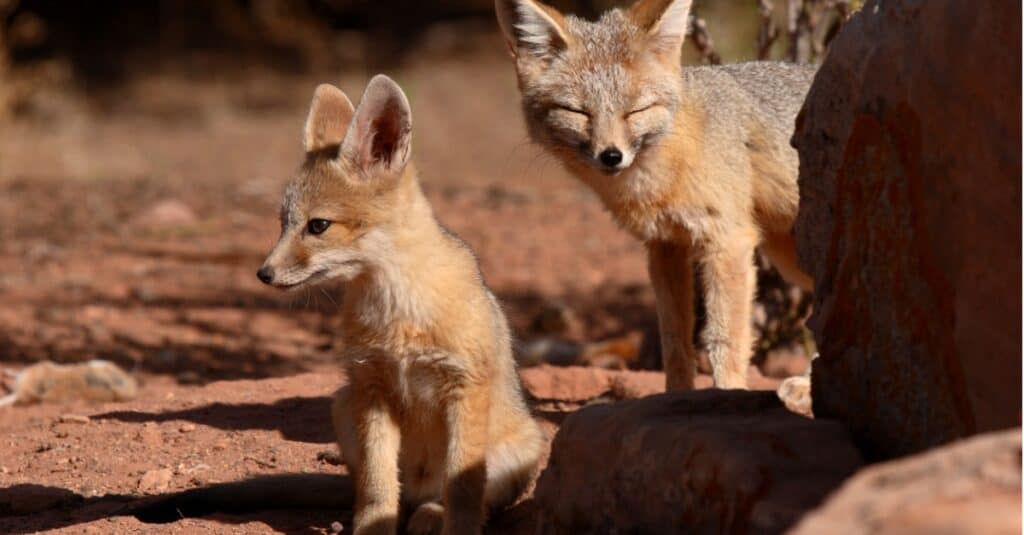
iStock.com/gatito33
Kit foxes prefer arid regions, ranging from central Mexico to the southwestern United States. They are primarily nocturnal and monogamous, tending to form pair bonds. Polygamy has been reported as well in this species, in which a single male will mate with multiple females. They typically establish mating pairs during October and November, and they mate from December to January, with an average litter of 4 or 5 born in February or March.
Ruppell’s Fox
These foxes can be found in the Middle East, southwestern Asia, and North Africa. Their preferred habitats are sandy or rocky deserts, scrublands, or steppes. Mating for this species occurs from November to January.
Bengal Fox
Also known as the Indian fox, the Bengal fox lives only on the Indian subcontinent. These foxes tend to prefer grasslands and semi-arid thorn or scrub forests. An article in Mammalian Species explains that in Gujarat, mating occurs from December to January, but elsewhere, mating is timed to the monsoon season and the availability of resources. Bengal foxes are a species that tend to be monogamous, and they’ll remain near their dens from February to June while they raise their pups.
More from A-Z Animals
.more-snake-card-image { max-height:140px !important; }
@media (min-width: 481px) {
.mobile-top-content {
display: none;
}
}
#mobileTopContentCTACarouselControls { overflow: hidden; text-overflow: ellipsis; white-space: nowrap; }
.mobile-top-content .more { color: #fff; }
.mobile-top-content a { color: #fff; text-decoration: underline; }
.mobile-top-content a:hover { color: #fff; text-decoration: underline; }
@media (max-width: 480px) {
.mobile-top-content {
background-color: #06a10b;
color: #fff;
text-align: center;
/*height: 60px;
padding-top:5px;*/
font-size:80%;
/* display: block; */
margin: 0px -30px;
}
}
As widespread members of the Caninae subfamily, foxes live on every continent aside from Antarctica. They live in forests, grasslands, deserts, mountains, and the arctic. As part of the genus Vulpes, they’re set apart from other canines like dogs, wolves, jackals, and coyotes. Foxes are smaller in size and length and have a bushier tail and flatter skull. There are twelve species of true foxes. Many species are monogamous, choosing one partner and mating for life. Let’s take a look at the fox mating season and find out when they breed.
When Is Fox Mating Season?

iStock.com/Wendy/Jeff Sparks/Torquemada
Fox mating season for most species occurs during the winter months of December through February. These mammals have a gestation period that averages 52 days. The young are then born in dens during the Spring.
Mating season varies by species, as foxes are widespread globally, and breeding may be influenced by the local climate and other factors. Below, we’ll take a look at the 12 true fox species and discover the variations in mating season timing.
Signs of Mating Season
Loud screeching noises that sound like crying are the mating calls of foxes, which may be heard out in the wild during the winter months. The screams and barks of urban foxes may wake the neighborhood during fox mating season. As males roam neighboring territories searching for receptive females, road deaths can be more common during this time.
Vixens, Tods, and Pups
A female fox is called a vixen, while a male is referred to as a tod or dog fox. Baby foxes are called kits, pups, or cubs. Many species tend to mate for life, but these pairs may or may not remain monogamous throughout that time. The practice of monogamy or promiscuity within foxes is based primarily on resource availability and population density. The vixens come estrous for 1 to 6 days during fox mating season, during which time they are receptive to being mated. The dog fox will ‘mate guard’ during this period, usually trailing the vixen as they sleep, hunt and travel together. He will fight with competing males if need be. Once mating has taken place, there is a gestation period of around 52 days before the young are born.
The vixens give birth in underground dens to a litter of 1 to 6 pups. Their eyes and ears remain closed for 10 to 15 days, so they are totally dependent on their parents for care and protection. Both parents usually care for the young, and the male fox will procure food for the female for weeks after she’s given birth. The babies are usually weaned at about 6 to 7 weeks old. They remain in the den for about a month and will remain with their parents until the fall.
Mating Season By Species
Red Fox

The largest species of fox is the red fox. They live in various regions in the Northern Hemisphere, from the Arctic Circle well into South America. They mate from late December through March, with most matings taking place in January and February. The vixens give birth to 4 to 5 pups in the spring. They tend to be solitary animals, aside from breeding season. Red Foxes appear to be a monogamous species.
Arctic Fox

rokopix/Shutterstock.com
Also called the polar fox, snow fox, or white fox, the arctic fox is well adapted to the cold climate of the Arctic tundra of the Northern Hemisphere. Mating season takes place in early March through early April. After gestation, the mother fox gives birth to a litter that averages 7 pups but may be as large as 15. These pups are born in dens 6 to 12 feet underground, carved out in sandy, well-drained soils of low mounds and river banks. The breeding range of the Arctic fox is primarily in the coastal regions of Canada and the High Arctic islands. As a monogamous species, both parents participate in rearing the pups. The family units that are formed during the breeding season tend to break up during September and October, and they lead a solitary life during the winter months.
Fennec Fox

pianoman555/Shutterstock.com
The smallest of all fox species, fennec foxes are native to the Sahara Desert, Sinai Peninsula, and the Arabian Desert. They have large ears, which help dissipate heat from their bodies. These animals are social creatures that dig burrows in the sand for habitation and protection and live in groups of up to ten individuals. They are nocturnal creatures who burrow underground to escape the desert heat. They’re also a monogamous species. Although their breeding season in the wild is not well documented, it’s believed to take place from January to February, with females giving birth to kits in March or April in their underground burrows.
Pale Fox
Pale foxes have sandy-colored coats that blend into the desert habitat of the Sahel region of Africa, where they live. Due to their remote habitat and exceptional camouflage, pale foxes are one of the least studied of all canids. They’re known to live in small family groups within underground burrows. Three adults usually form a pack in this species, with one female and two males. Their mating season is unknown, but mothers typically give birth to 3 to 6 pups.
Blanford’s Fox
Also known as the Afghan fox, royal fox, and dog fox, the Blandford’s fox lives in parts of Central Asia and the Middle East in mountains, steppes, and arid plains regions. These foxes are a monogamous species that form pairs in January and February. They have a 50 to 60-day gestation period and give birth to 1 to 3 kits.
Cape Fox
Also called the asse, cama fox, and silver-backed fox, the Cape fox is a small species that live in Southern Africa. Breeding season takes place during the winter months of the Southern Hemisphere, during July and August. Monogamy may occur, but the details of this species’ mating habits are not well understood. Mates typically only have contact during mating season. After a gestation of about 52 days, the vixen gives birth to 1 to 6 kits in an underground burrow. Several females may share the same den, which the cubs don’t leave until around four months old. Both parents rear the young. The male provides food for the vixen for 1 to 2 weeks or more after she’s given birth to the litter.
Corsac Fox
Also known as the steppe fox and the sand fox, the corsac fox lives in deserts and steppes in Central Asia and can go long periods without food or water as an adaptation to the environment. These foxes are nocturnal in the wild, but in captivity tend to stay up all day. They are a monogamous species. They’re more social than other foxes, forming hunting packs in the winter and living in shared or adjoining burrows. Mating season occurs between January and March, and babies are born after a 52-day gestation period.
Tibetan Fox

Wang LiQiang/Shutterstock.com
The Tibetan fox, or Tibetan sand fox, lives in semi-arid or arid highlands. These foxes are found mainly in the vicinity of the Tibetan and the Ladakh Plateau. They’re a monogamous species that live and hunt in mated pairs. Most meet their partner after their first year, but some mate later in life. Mating occurs from late February to March for this species, and typically 2 to 5 pups are born during May.
Swift Fox
The western grasslands of North America are home to the swift fox. Swift foxes form their dens in the sandy soil of open prairies, plowed fields, or along fences. The dog fox will typically mate at one year, while the vixen may wait until her second year to begin breeding. They form pairs but may or may not stay with the same mate each year. In the southern United States, mating takes place from December to February. In Canada, this happens in March, and babies are born in mid-May. The social organization of this species is unique in that it is based on the females. The vixens maintain territories at all times.
Kit Fox

iStock.com/gatito33
Kit foxes prefer arid regions, ranging from central Mexico to the southwestern United States. They are primarily nocturnal and monogamous, tending to form pair bonds. Polygamy has been reported as well in this species, in which a single male will mate with multiple females. They typically establish mating pairs during October and November, and they mate from December to January, with an average litter of 4 or 5 born in February or March.
Ruppell’s Fox
These foxes can be found in the Middle East, southwestern Asia, and North Africa. Their preferred habitats are sandy or rocky deserts, scrublands, or steppes. Mating for this species occurs from November to January.
Bengal Fox
Also known as the Indian fox, the Bengal fox lives only on the Indian subcontinent. These foxes tend to prefer grasslands and semi-arid thorn or scrub forests. An article in Mammalian Species explains that in Gujarat, mating occurs from December to January, but elsewhere, mating is timed to the monsoon season and the availability of resources. Bengal foxes are a species that tend to be monogamous, and they’ll remain near their dens from February to June while they raise their pups.






